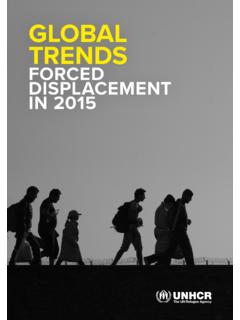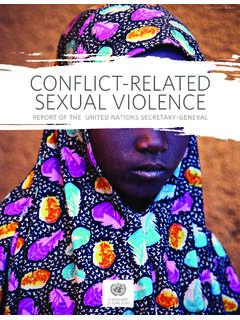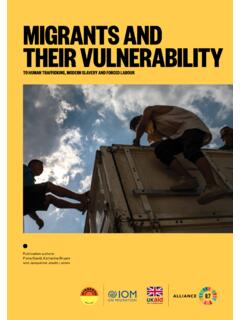Transcription of GLOBAL STUDY ON HOMICIDE 2018
1 2018 GLOBAL STUDY ON HOMICIDEG ender-related killing of women and girlsUNITED NATIONS OFFICE ON DRUGS AND CRIME Vienna GLOBAL STUDY ON HOMICIDE Gender-related killing of women and girls 2018 The gender related killing of women and girls 2 DISCLAIMERS United Nations, November 2018. All rights reserved worldwide. This publication may be reproduced in whole or in part and in any form for educational or non-profit purposes without special permission from the copyright holder, provided acknowledgement of the source is made. The United Nations Office on Drugs and Crime (UNODC) would appreciate receiving a copy of any publication that uses this publication as a source. Suggested citation: UNODC, GLOBAL STUDY on HOMICIDE 2018 (Vienna, 2018) No use of this publication may be made for resale or any other commercial purpose whatsoever without prior permission in writing from UNODC.
2 Applications for such permission, with a statement of purpose and intent of the reproduction, should be addressed to the Research and Trend Analysis Branch of UNODC. DISCLAIMER The content of this publication does not necessarily reflect the views or policies of UNODC or contributory organizations, nor does it imply any endorsement. Comments on the report are welcome and can be sent to: Division for Policy Analysis and Public Affairs United Nations Office on Drugs and Crime PO Box 500 1400 Vienna Austria Tel: (+43) 1 26060 0 Fax: (+43) 1 26060 5827 Gender related killing of women and girls 3 Preface HOMICIDE represents the most extreme form of violence against women, a lethal act on a continuum of gender-based discrimination and abuse.
3 As this research shows, gender-related killings of women and girls remain a grave problem across regions, in countries rich and poor. While the vast majority of HOMICIDE victims are men, killed by strangers, women are far more likely to die at the hands of someone they know. Women killed by intimate partners or family members account for 58 per cent of all female HOMICIDE victims reported globally last year, and little progress has been made in preventing such murders. Targeted responses are clearly needed. This booklet part of the forthcoming GLOBAL STUDY on HOMICIDE by the United Nations Office on Drugs and Crime (UNODC) is being released on the International Day for the Elimination of Violence against Women 2018 to raise awareness, increase understanding and inform action.
4 It is also a call for Governments to help us shed further light on these challenges by collecting the needed data and reporting on all forms of gender-based violence. UNODC remains committed to supporting Member States to strengthen evidence-based policies and criminal justice responses that can prevent and end violence against women and gender-related killings. Yury Fedotov Executive Director, United Nations Office on Drugs and Crime 4 Acknowledgements Gender-related killing of women and girls was prepared by the Research and Trend Analysis Branch, Division for Policy Analysis and Public Affairs, United Nations Office on Drugs and Crime, under the supervision of Jean-Luc Lemahieu, Director of the Division, and Angela Me, Chief of the Research and Trend Analysis Branch.
5 General coordination and content overview Angela Me Andrada-Maria Filip Marieke Liem Analysis and drafting Andrada-Maria Filip Jonathan Gibbons Marieke Liem Kristiina Kangaspunta Data management and estimates production Enrico Bisogno Diana Camerini Sarika Dewan Michael Jandl Alexander Kamprad Mateus Renn Santos Graphic design and production Anja Korenblik Suzanne Kunnen Kristina Kuttnig Administrative support Iulia Lazar Review and comments Gender-related killing of women and girls benefited from the expertise of and invaluable contributions from UNODC colleagues in all divisions and field offices. Particular thanks are owed to the Justice Section of the Division of Operations and the Gender Team at the Office of the Executive Director.
6 Cover drawing Yasser Rezahi; photo of artwork Fabian Rettenbacher. The research for this STUDY was made possible by the generous contribution of Sweden. Gender related killing of women and girls 5 Contents Preface .. 3 Contents .. 5 Scope of the STUDY .. 7 Introduction to the concept of gender-related killing of women and girls .. 8 Key findings .. 10 Intimate partner/family-related killing of women and girls: scale of the problem .. 13 Scale of the problem in numbers of victims ..13 Scale of the problem in HOMICIDE rates ..13 Scale of the problem in shares of all women murdered ..17 Female burden of intimate partner/family-related HOMICIDE ..18 Male and female rates of intimate partner/family-related HOMICIDE .
7 19 Male and female rates of intimate partner HOMICIDE ..21 The context of gender-related killing of women and girls ..22 Defining and understanding gender-related killing of women and girls .. 24 Clustering gender-related killings of women and girls into different forms ..29 Perpetrators of intimate partner killings of women and girls .. 38 Victim and perpetrator characteristics ..38 Motives of perpetrators of intimate partner killings of women and girls ..39 Link between lethal and non-lethal violence against women .. 41 Criminal justice and policy responses to gender-related killing of women and girls .. 47 International responses ..47 National responses ..48 Conclusions and Policy Implications.
8 55 Annex .. 57 Gender related killing of women and girls 7 Scope of the STUDY This STUDY gives an overview of the scope of gender-related killing of women and girls. It provides in-depth analysis of killings perpetrated within the family sphere and examines forms of gender-related killings perpetrated outside the family sphere, such as the killing of women in conflict and the killing of female sex workers. The STUDY explores the scale of intimate partner/family-related killings of women and girls, and describes different forms of gender-related killings of women. It also looks at the characteristics of the perpetrators of intimate partner killings, the link between lethal and non-lethal violence against women, and the criminal justice response.
9 The availability of data on intimate partner/family-related HOMICIDE means that such killings of females are analysed in greater depth than other forms of femicide 1 and that the analysis focuses on how women and girls are affected by certain norms, harmful traditional practices and stereotypical gender roles. Although other forms of gender-related killing of women and girls are described, such as female infanticide and the killing of indigenous or aboriginal women, given severe limitations in terms of data availability, only literature-based evidence is provided. The data presented in this STUDY are based on HOMICIDE statistics produced by national statistical systems in which the relationship between the victim and perpetrator or the motive is reported.
10 While the disaggregation of HOMICIDE data at country level has improved over the years, regional and GLOBAL estimates are based on a limited number of countries, with Africa and Asia accounting for most of the gaps.. 1 Throughout this STUDY the word femicide is written with quotation marks when it refers to a concept that is not clearly defined and covers acts subject to a certain degree of interpretation. Femicide is written without quotation marks when referring to countries in Latin America that have defined this concept in their national legislation. Gender related killing of women and girls 8 Introduction to the concept of gender-related killing of women and girls The focus of this STUDY is on the killing of women and girls as a result of gender norms.



















